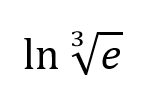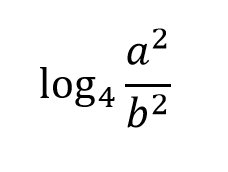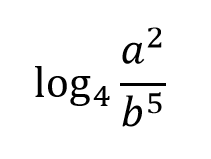This has an exact value:

What is 1/3
Solve for x:
5^(2x)=21
x=log_5(21)/2
Evaluate the following log.
log4(1/64)
-3
Solve for x:
2*3^(x-5)=12
x=log_3(6)+5
Convert to Exponential Form:
log_(x-1)(4)=2y
(x-1)^(2y)=4
Evaluate the following log.
ln(e10)
10
Solve using Logarithms:
log_(x+2)(16)=2
x=2
If f (x) = −9x − 9
and
g(x)=
sqrt(x-9)
find f(g(10))
What is f(g(10))=-18 ?
Given the functions h(x) = 2x - 6 and g(x) = x+ 4
What is h(g(x))
h(g(x)) = 2(x+4) - 6
= 2x +8 -6
= 2x + 2
Solve: log5(2x-7)=log5(3x-9)
no solution
Round to the nearest thousandth.
1.7712
State the transformations:
f(x)=-ln(x-4)+1
-: reflection over the x-axis
x-4: right 4
+1: up 1
Convert to Logarithmic Form:
e^(x+4)=2y-7
ln(2y-7)=x+4
Completely expand the following logarithms.
log54(x)1/3
log54 + (1/3)log5(x)
This can be written as a single logarithm
What is:
State the Transformations:
2log(x-3)
2: Vertical Stretch by 2
x-3: Right 3
Write the inverse function of
f(x)=4e^x
ln(x/4)
Inverse Functions
The reason the inverse of the points below is not a function:
(1, 4), (-3, 5), (2, 4), (1, 4)
What is there is more than one output for the input of 4?
Solve: 5x-4=25x-6
What is 8?
Solve.
log_4(x)=-5
x=
x = 1/1024
Solve for x:
2ln(2)+ln(x)=ln(x+12)
x=4
Solve: log2x+log2(x-2)=3
4
Solve for x:
2*e^(3x-1)-7=13
x=(ln10+1)/3
This can be written as the sum and difference of multiple logarithms:


What is:

Solve for x:
3log(4)-log(x)=log(2)
x=32
Given f(x) = x2 and g(x) = x - 4
What is f(g(x))? Fully simplify your answer
f(g(x)) = (x - 4)2
=(x -4) (x - 4)
= x2 -4x -4x +16
= x2 -8x +16
The DOMAIN of the function log(x)
(0, infinity) or x>0
What is the domain of
ln(x-1)
x>1
or
(1,infinity)
Find the inverse.


Given f(t)=
t^2 -t
and h(x)=3x+2
Evaluate f(h(1))
What is f(h(1))=20 ?